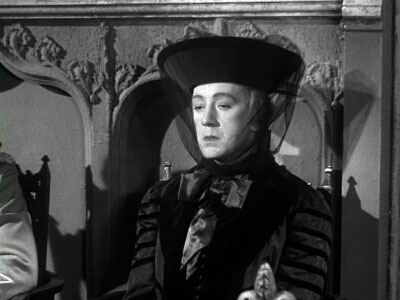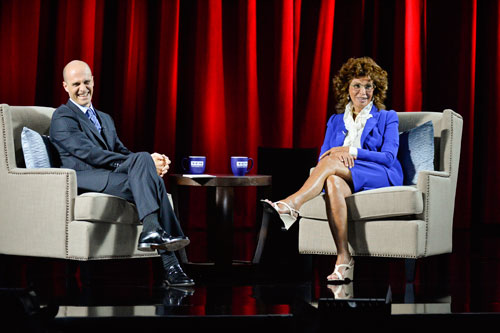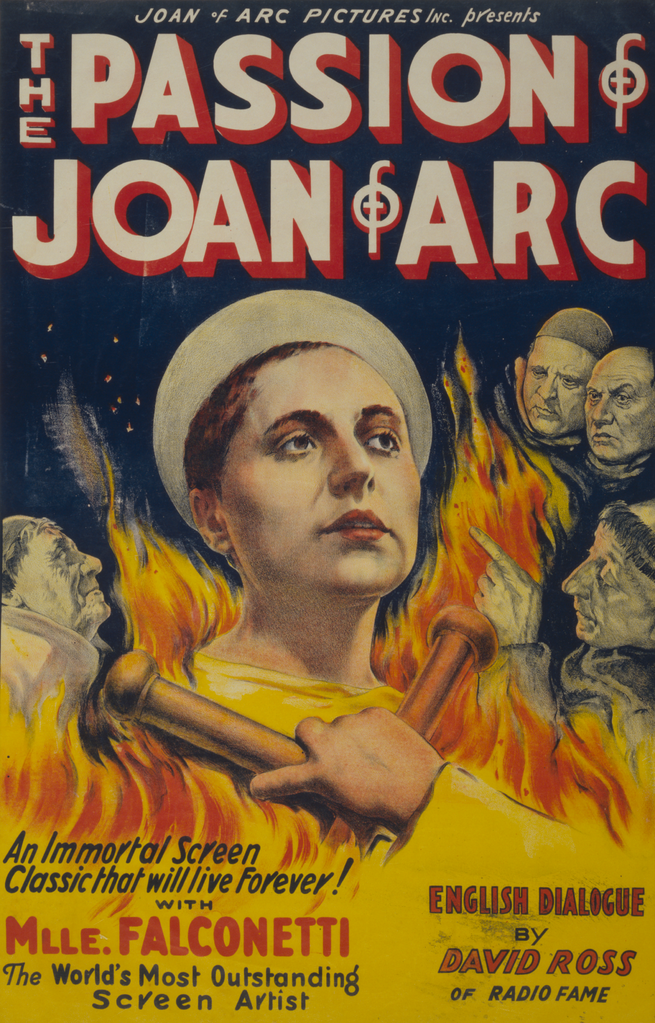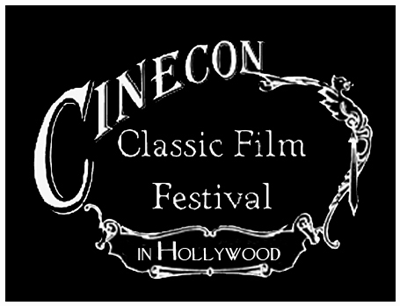Dear readers, the TCM Classic Film Festival is just over a week away. Like other festival attendees, I have been busy creating my festival itinerary, doing my yearly grumble over time slot conflicts, and comparing overlaps with my friends’ schedules. I thought I’d share with you what I have so far, and explain for those new followers the way the festival works.
The TCM Classic Film Festival is designed for passholders. This means that everyone possessing a pass is entitled to stand in line for festival films, and, if the passholder gets in line early enough, be admitted to screenings. This does not mean, however, that the passholder is guaranteed a seat.
Let’s get creative for a minute, and explain the festival through the eyes of the average festivalgoer. (This is inspired by one of my favorite videos from the WWII homefront. Check out this system of explaining point rations.)
Let’s create a hypothetical TCM passholder–we’ll name her Joan (a disproportionately common name among classic Hollywood actresses, it seems). Joan decided to go for the Classic Pass this year, and paid her $649 to TCM for it. With the Classic Pass, she is entitled to all screenings except the Opening Night movie (When Harry Met Sally this year). That event is reserved for Essential and Spotlight passholders only. Those pass levels are significantly more expensive, and Joan wasn’t interested enough in When Harry Met Sally to pay the extra money to see it. She is also given admission to Club TCM, which will allow her to experience any and all panel discussions that she wants.
Her hypothetical friend Clark decides to splurge on the Spotlight Pass this year. He wants to have the experience of seeing the celebrity arrivals, and going to the fancy opening night party. With his Spotlight Pass, which is nearly $1,500 more expensive than Joan’s pass, he will get these experiences and have a memorable Hollywood vacation that encompasses more than just movies.
Joan’s Classic Pass arrives in the mail about a month before the festival. Once she gets to Los Angeles on Monday night (the festival starts on Thursday, and most people arrive a few days early to get settled), she does some sightseeing of classic film star homes, hikes up to the Hollywood sign, and takes the TCM Festival-sponsored bus tour that takes her around to various places in the city important to film history.
Once Thursday rolls around, she’s ready for her movies. She and Clark have compared schedules, and while Clark is seeing When Harry Met Sally on Thursday night, Joan will see Gentlemen Prefer Blondes at the Egyptian, followed by The Umbrellas of Cherbourg. First, though, Joan decides to watch the celebrity arrivals for When Harry Met Sally. She is allowed access to the bleachers with her Classic Pass, but only Spotlight and Essential festivalgoers are allowed on the red carpet. She sees Billy Crystal and Meg Ryan arrive, waves to her friend Clark who is on the red carpet right beside Angie Dickinson, then she decides to go get in line for Gentlemen Prefer Blondes.

Shirley Jones waves to the bleachers before the opening night showing of Oklahoma! in 2015.
This is where it gets interesting. Because she has a Classic Pass, she must arrive at the movie at least an hour before showtime in order to secure her place in line and get a decent line number. If a festivalgoer at the Classic Pass level arrives too late, she risks the movie “selling out” and then she’s out of luck.
Line numbers are handed out in order for the festivalgoers to maintain their place in line while they leave to get a cup of coffee, a quick sandwich, or just a quick rest. Spotlight passholders are let in first, and if the Classic passholder is not back in line by the time the movie begins letting in, their place in line is forfeited and they risk not seeing the movie. This is an absolutely essential part of the festival experience that I think is not terribly well publicized, so if you are planning to go, keep this in mind.
Joan wants to see The Umbrellas of Cherbourg next, but she knows that she’s not going to have enough time between Gentlemen Prefer Blondes and The Umbrellas of Cherbourg to get a decent line number. She wants to see Umbrellas of Cherbourg enough that she’s willing to sacrifice the ending of Gentlemen Prefer Blondes in order to see it. Clark will be going to the opening night party after he is finished with When Harry Met Sally, but if he had been in the same situation as Joan, he would not have had to worry about missing the end of the movie. He is all but guaranteed entry to anything he wants to see, regardless of when he gets in line.

Some very savvy festivalgoers with their line numbers.
This is really the main difference between the pass levels. Spotlight passholders are paying for convenience and paying to have a relaxed, memorable vacation along with their movies. Classic passholders are really there for the movies, and the vacation part of it is secondary.
Also, you will notice that there is a marked hierarchy in the festival operations, which is understandable given the price differences. However, $649 is still a lot of money to pay, and many hardcore TCM fans, especially those in the key TCM demographic (the 60% of TCM viewers under 40–which may come as a surprise) are priced out of the festival altogether. Given the rising cost of living in urban America, and with millennials barely able to make rent, most of TCM’s most devoted fans, sadly, cannot attend. Backlots attends with media credentials, so while I am indeed a millennial in TCM’s key demographic, for the past 7 years I have not had to face this problem myself. But I recall my first year at the festival, when Backlots was brand new, and I purchased a Classic Pass in order to be able to attend for sure. The pass cost nearly half my monthly salary at the time, and I know that this is the situation for many of my friends to this day.
The media credential that Backlots receives is essentially the Classic Pass, which has always worked perfectly for me. It gives me access to everything I need to fully cover the festival for my readers, and have a great deal of fun along the way. As of right now, my festival schedule looks like this:
THURSDAY NIGHT:
Umbrellas of Cherbourg

I had originally planned to see Gentlemen Prefer Blondes as well, but it turns out I have a non-festival-related conflict at that time, so I’ll have to skip that one and go straight on to Umbrellas of Cherbourg. This is a film that I have nearly committed to memory, but have never seen on the big screen. I’m told it’s a completely different experience, and I’m looking forward to seeing those beautiful bright pastels the way they were meant to be seen.
FRIDAY:
Merrily We Go To Hell

I’m excited for this one for several reasons. Pre-codes are always some of the most popular offerings at the TCM Festival, so the crowd is sure to be top notch and excited. It is also in one of the smaller theaters (the festival frequently underestimates crowd size for the pre-codes), so if you’re going to the festival and planning to attend this one with me, be sure to get in line VERY early.
The movie is directed by the great Dorothy Arzner, one of the pre-eminent female directors of early Hollywood, and the TCM Festival did right in securing Cari Beauchamp as the presenter for Merrily We Go to Hell. As the author of Without Lying Down: Frances Marion and the Powerful Women of Early Hollywood, Beauchamp is the reigning expert on Dorothy Arzner and her role in the development of early Hollywood–and has also established herself as one of the festival’s most beloved veteran presenters. Don’t miss this one.
Sunrise: A Song of Two Humans

One of my all-time favorite silent films, with some of the most unusual and arresting intertitles that I’ve ever seen. It is a masterpiece of characterization and cinematography, following the relationship of a husband and wife, with the conflicting desires of the husband coming between them. It is one of the three movies for which Janet Gaynor received the first Best Actress Oscar, and out of the three, it is indubitably the technical greatest.
Kerry Brougher, former president of the Academy of Motion Picture Arts & Sciences along with other illustrious titles, will be presenting this movie. It promises to be an interesting presentation, due to Brougher’s work as curator of several film-related retrospectives at the Smithsonian and Museum of Contemporary Art in Los Angeles, including one on Hitchcock. Sunrise is indeed very Hitchcockian, which may be something I write about during the festival.
Vanity Street

Another pre-code about a young woman in poverty who commits a crime and falls in love with the policeman who catches her, this one promises to be another crowded theater (it’s showing in the smallest theater of the festival). I may have to leave early from Sunrise to get in line for this one, but the pre-codes are almost always the most satisfying movies of the entire festival. Vanity Street features another Cari Beauchamp introduction, which promises to be very informative especially as it relates to actress Helen Chandler. Despite her work in several well known movies, Chandler’s life was very difficult, with bouts of alcoholism and psychological distress. She never had children, and her ashes still lie unclaimed at Chapel of the Pines.
SATURDAY
Kind Hearts and Coronets

Alec Guinness plays various members of an aristocratic family, the d’Ascoynes, in this brilliant dark comedy about one d’Ascoyne trying to kill everyone ahead of him for the dukedom. My favorite member of the family: suffragette Lady Agatha d’Ascoyne.
The discussion beforehand will be with Jefferson Mays, a leading television actor who has acted in several notable shows such as I Am the Night and The Unbreakable Kimmy Schmidt. I’ll be curious to see what his relationship to Kind Hearts and Coronets is. TCM frequently secures well known modern day actors for the festival who have a heretofore unknown interest in classic film, so I’m looking forward to hearing what he has to say.
Hollywood Home Movies at Club TCM

This event is always one of the cornerstones of the festival. The Academy of Motion Picture Arts and Sciences brings in previously unseen footage of classic film stars and, with simultaneous conversation with the people close to them, sitting in the front row of Club TCM, this footage is shown to passholders. It’s one of my favorite events, and this year’s footage will include John Huston and Olivia de Havilland, Greta Garbo, Hedy Lamarr, Jimmy Stewart, and more.
I am very happy that the Classic and Media passes include access to Club TCM. In my view, the events at Club TCM (located in the Blossom Room at the Hollywood Roosevelt Hotel, the site of the first Oscars ceremony) are the soul of the festival, and they are not to be missed. This is where the real learning happens.
It Happened Here

Kevin Brownlow, film archivist and preservationist extraordinaire, will be receiving the Robert Osborne Award this year for his unparalleled work in preservation and restoration of silent films. It Happened Here is one of Brownlow’s crowning achievements outside of preservation, a film about what might have happened if Hitler had been successful in World War II.
Kevin Brownlow has been exceedingly generous with me in my Marion Davies work, and when I heard that he would be getting the Robert Osborne Award, I couldn’t think of anyone more deserving. When I met him in London several years ago, he spoke very proudly of It Happened Here, and I can’t wait to see it on the big screen with Brownlow in attendance.
Indiscreet

Cary Grant and Ingrid Bergman team up for the second time after Notorious, this time directed by Stanley Donen. The plot is quite creative for a 1958 code-era movie, an actress falls in love with a man she believes to be married only to find out that he’s actually single, and she vows to get back at him for misleading her.
Stanley Donen passed away earlier this year, and Indiscreet‘s screening at the festival is a way for TCM to honor him. This movie features another Cari Beauchamp introduction–my choices seem to line up well with her intros this year. In addition to her work on women of early Hollywood, Beauchamp is also an expert on the life and work of Cary Grant, and this article she wrote on Grant and his connection to LSD use in Hollywood is a fascinating read.
SUNDAY
Holiday

How could I miss this one? One of my favorite Katharine Hepburn movies of all time, and one I find is consistently underrated in her pantheon of greats. Hepburn plays the black sheep of a wealthy family, who wants nothing more than to live a fun and normal life in spite of her stuffy family. Cary Grant, who lives the life she wants, has fallen in love with her much more traditional sister, and when he comes over to meet the family, he starts to fall for her instead.
I have always been impressed with how modern the movie is–in some ways, it reminds me of The Philadelphia Story in its sophistication and quality of writing.
The special guest for this movie is Diane Baker, which should be wonderful. Baker has become a mainstay of the festival, and has always been very approachable and appreciative of the love she receives. I will be interested to hear what she says about Holiday, and what it has meant to her and her career.
Gone With the Wind

The remainder of my festival, before the closing night party, will be taken up by Gone With the Wind. I have seen the movie on the big screen innumerable times, but this time will be different–it is screening at Grauman’s Chinese Theatre. I feel that I can’t miss that.
Prior to the screening, at Club TCM, there will be a panel discussion on the film’s complicated legacy. Indeed, the movie is and has always been complicated, and I’m glad that TCM is offering this discussion for people who may be hesitant to attend the showing due to content that has not aged well and, indeed, was controversial even in 1939. At the panel discussion will be historian Donald Bogle, Mollie Haskell, Jacqueline Stewart, and Stephanie Allain, discussing the issues surrounding the movie and what its status will be in the future.
Closing Night Party
This is our last opportunity to say goodbye to our friends until next year, held at Club TCM. People come from all over the world to attend the festival, and while the digital age has made keeping in touch very easy, many of us count down the days until we can see our TCM friends again. It’s normally very difficult to leave the closing night party, because this means that the festival is officially over, and that countdown to next year begins.
I will be using Twitter quite a lot during the festival, and as usual, will be enabling a live Twitter feed on the blog so that readers may follow along in real time. I usually make a blog post every evening after the events of the day, so keep an eye out for updates.
See you at the festival!


































_02.jpg)
































_03.jpg)

